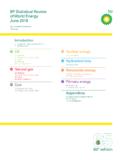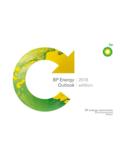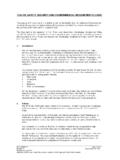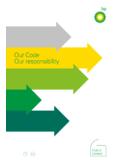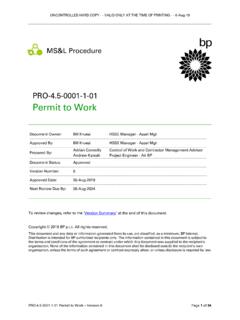Transcription of Material Safety Data Sheet
1 Material Safety Data Sheet 1 . Identification of the Material and supplier Product name AdBlue SDS no. 0000003947. Product use Reactant for reducing NOx-emissions. Supplier BP Australia Pty Ltd Level 17, 717 Bourke Street Docklands, Victoria 3008. ABN 53 004 085 616. Technical Helpline Number: 1300 139 700. EMERGENCY TELEPHONE 1800 638 556. NUMBER. Product code 0000003947. 2 . Hazards identification Statement of hazardous/ NON-HAZARDOUS SUBSTANCE. NON-DANGEROUS GOODS. dangerous nature 3 . Composition/information on ingredients Water and Urea ( - ). This product does not contain any hazardous ingredients at or above regulated thresholds. 4 . First-aid measures Eye contact In case of contact, immediately flush eyes with plenty of water for at least 15 minutes. Eyelids should be held away from the eyeball to ensure thorough rinsing. Check for and remove any contact lenses. Get medical attention if irritation occurs.
2 Skin contact Flush contaminated skin with plenty of water. Remove contaminated clothing and shoes. Wash clothing before reuse. Clean shoes thoroughly before reuse. Get medical attention if irritation develops. Inhalation If inhaled, remove to fresh air. Get medical attention if symptoms appear. In case of inhalation of decomposition products in a fire, symptoms may be delayed. The exposed person may need to be kept under medical surveillance for 48 hours. Ingestion Do not induce vomiting unless directed to do so by medical personnel. Get medical attention if symptoms occur. Advice to doctor Treatment should in general be symptomatic and directed to relieving any effects. 5 . Fire-fighting measures Extinguishing media Suitable In case of fire, use foam, dry chemical or carbon dioxide extinguisher or spray. Not suitable Do not use water jet. Hazardous decomposition Combustion products may include the following: products carbon oxides (CO, CO2) (carbon monoxide, carbon dioxide).
3 Nitrogen oxides Unusual fire/explosion In a fire or if heated, a pressure increase will occur and the container may burst. hazards Special fire-fighting No action shall be taken involving any personal risk or without suitable training. Promptly isolate the procedures scene by removing all persons from the vicinity of the incident if there is a fire. Protection of fire-fighters Fire-fighters should wear appropriate protective equipment and self-contained breathing apparatus (SCBA) with a full face-piece operated in positive pressure mode. Product name AdBlue Product code 0000003947 Page: 1/5. Version 1 Date of issue 16 September 2013 Format Australia Language ENGLISH. (Australia) (ENGLISH). 6 . Accidental release measures Personal precautions No action shall be taken involving any personal risk or without suitable training. Evacuate surrounding areas. Keep unnecessary and unprotected personnel from entering.
4 Do not touch or walk through spilt Material . Put on appropriate personal protective equipment (see Section 8). Environmental precautions Avoid dispersal of spilt Material and runoff and contact with soil, waterways, drains and sewers. Inform the relevant authorities if the product has caused environmental pollution (sewers, waterways, soil or air). Large spill Stop leak if without risk. Move containers from spill area. Prevent entry into sewers, water courses, basements or confined areas. Wash spillages into an effluent treatment plant or proceed as follows. Contain and collect spillage with non-combustible, absorbent Material sand, earth, vermiculite or diatomaceous earth and place in container for disposal according to local regulations. Dispose of via a licensed waste disposal contractor. Small spill Stop leak if without risk. Move containers from spill area. Dilute with water and mop up if water- soluble.
5 Alternatively, or if water-insoluble, absorb with an inert dry Material and place in an appropriate waste disposal container. Dispose of via a licensed waste disposal contractor. 7 . Handling and storage Handling Put on appropriate personal protective equipment. Storage Store and use only in equipment/containers designed for use with this product. Keep away from heat and direct sunlight. Keep container tightly closed and sealed until ready for use. Containers that have been opened must be carefully resealed and kept upright to prevent leakage. Do not store in unlabelled containers. Store in accordance with local regulations. Store in a dry, cool and well- ventilated area, away from incompatible materials (see Section 10). Not suitable Prolonged exposure to elevated temperature. 8 . Exposure controls/personal protection Occupational exposure limits No exposure standard allocated.
6 Biological Limit Values No biological limit allocated. Exposure controls Occupational exposure Provide exhaust ventilation or other engineering controls to keep the airborne concentrations of controls vapours below their respective occupational exposure limits. All activities involving chemicals should be assessed for their risks to health, to ensure exposures are adequately controlled. Personal protective equipment should only be considered after other forms of control measures ( engineering controls) have been suitably evaluated. Personal protective equipment should conform to appropriate standards, be suitable for use, be kept in good condition and properly maintained. Your supplier of personal protective equipment should be consulted for advice on selection and appropriate standards. For further information contact your national organisation for standards. The final choice of protective equipment will depend upon a risk assessment.
7 It is important to ensure that all items of personal protective equipment are compatible. Hygiene measures Wash hands, forearms and face thoroughly after handling chemical products, before eating, smoking and using the lavatory and at the end of the working period. Ensure that eyewash stations and Safety showers are close to the workstation location. Personal protective equipment Respiratory protection Respiratory protective equipment is not normally required where there is adequate natural or local exhaust ventilation to control exposure. In case of insufficient ventilation, wear suitable respiratory equipment. The correct choice of respiratory protection depends upon the chemicals being handled, the conditions of work and use, and the condition of the respiratory equipment. Safety procedures should be developed for each intended application. Respiratory protection equipment should therefore be chosen in consultation with the supplier/manufacturer and with a full assessment of the working conditions.
8 Skin and body Use of protective clothing is good industrial practice. Personal protective equipment for the body should be selected based on the task being performed and the risks involved and should be approved by a specialist before handling this product. Cotton or polyester/cotton overalls will only provide protection against light superficial contamination that will not soak through to the skin. Overalls should be laundered on a regular basis. When the risk of skin exposure is high ( when cleaning up spillages or if there is a risk of splashing) then chemical resistant aprons and/or impervious chemical suits and boots will be required. Hand protection Wear protective gloves if prolonged or repeated contact is likely. The correct choice of protective gloves depends upon the chemicals being handled, the conditions of work and use, and the condition of the gloves (even the best chemically resistant glove will break down after repeated chemical exposures).
9 Most gloves provide only a short time of protection before they must be discarded and replaced. Because specific work environments and Material handling practices vary, Safety procedures should be developed for each intended application. Gloves should therefore be chosen in consultation with the supplier/manufacturer and with a full assessment of the working conditions. Eye protection Safety glasses with side shields. Product name AdBlue Product code 0000003947 Page: 2/5. Version 1 Date of issue 16 September 2013 Format Australia Language ENGLISH. (Australia) (ENGLISH). 9 . Physical and chemical properties Physical state Liquid. Colour Clear. Colourless. Odour Ammoniacal. [Slight]. Vapour pressure Not available. Vapour density Not available. pH Boiling point / range Not available. Melting point / range Not available. Relative density/Specific Not available. gravity Density 1094 kg/m ( g/cm ) at 20 C.
10 Solubility Soluble in water. Partition coefficient <1. (LogKow). 10 . Stability and reactivity Stability The product is stable. Conditions to avoid Avoid contamination by any source including metals, dust and organic materials. Incompatibility with various No hazardous reactions identified. substances/Hazardous Reactions Hazardous decomposition Combustion products may include the following: products carbon oxides (CO, CO2) (carbon monoxide, carbon dioxide). nitrogen oxides 11 . Toxicological information Eyes No significant health hazards identified. Skin No significant health hazards identified. Inhalation No significant health hazards identified. Ingestion Ingestion of large quantities may cause nausea and diarrhoea. Acute toxicity Unlikely to cause more than transient stinging or redness if accidental eye contact occurs. Unlikely to cause harm to the skin on brief or occasional contact but prolonged or repeated exposure may lead to dermatitis.
